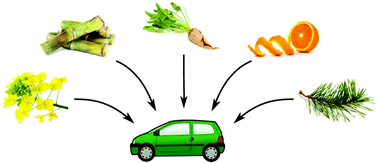New completely renewable biofuels: formulations and engine tests on an unmodified up-to-date diesel engine
Abstract
New completely green biofuels with rapeseed oil as the main component were formulated. They not only fulfil the principles of green chemistry and thus do not contain any environmentally harmful additives, but also match the currently valid standards for biodiesel regarding their physicochemical properties. Using a vegetable oil as a fuel component, its major drawbacks, high kinematic viscosity and high freezing point, had to be fixed. It could be shown that the properties of mixtures of rapeseed oil with and without its corresponding fatty acid methyl ester, so-called biodiesel, can be adjusted by several further components. For this purpose, different furan derivatives and terpenes could be used to fulfil the American and European viscosity standards for biodiesel. The furan derivatives stem from sugar and cellulose, whereas terpenes are mainly constituents of essential oils of trees and the peels of citrus plants as well as producible by the bio-transformation of sugarcane. With furan derivatives as further fuel components, the amount of necessary biodiesel could be drastically reduced, and cloud points below −20 °C were obtained. Using terpenes, these conditions could be matched without any biodiesel in the formulations, and cloud points even below −40 °C were achieved. To further characterise these biofuel formulations, ignition, combustion and emission tests were performed on an up-to-date 2.2 L diesel engine using a blend of rapeseed oil, rapeseed oil-based biodiesel and 2-methylfuran. The results showed that the properties of the formulated biofuel were similar to or even better than those of common diesel despite the high requirement profile of modern diesel formulations. Besides improving the relevant physicochemical parameters of the fuel, 2-methylfuran also increased its oxygen content. This enhanced the soot oxidation and therefore led to a complete inhibition of soot emissions. Nevertheless, the main drawback of biofuels in general, slightly higher NOx emissions than diesel, still remained, which requires a common exhaust gas aftertreatment of diesel engines. In the scope of this paper, the new formulations are discussed with regard to the concept of green and sustainable chemistry.



 Please wait while we load your content...
Please wait while we load your content...